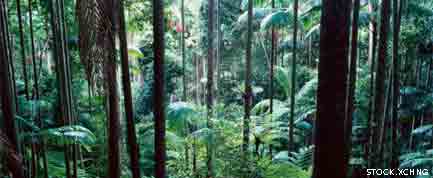After 250 Years of Classifying Life, 90 Percent Remains Unknown

BRONX, NEW YORK--Most people can tell the difference between some types of berries, or bugs or trees, but much of the planet's life remains unnamed and unseen. A stunningly egotistical Swedish naturalist, Carl Linnaeus, tried long ago to set humanity on track to remedy that. His book, "Systema Naturae," first published in 1735 at 13 pages long, proposed a hierarchical system for classifying plants, animals and minerals (we later chipped away minerals into the domain of geology) and launched an effort to identify and inventory all the world's living things. Now 250 years after publication of the book's latter editions, scientists still have discovered as few as 10 percent of the species now living on Earth, said Harvard biologist Edward O. Wilson, who spoke here last week at an event at the New York Botanical Garden to celebrate a visit of Linnaeus' personal copy of the book's first edition. "We live, in short, on a little-known planet. When dealing with the living world, we are flying mostly blind," Wilson said. "When we try to diagnose the health of an ecosystem, such as a lake or a forest, in order to save and stabilize it we are in the position of a doctor trying to treat a patient, knowing only 10 percent of organs." Linnaeus' launch of a global inventory of life was one of his most influential contributions to science, said Wilson, a proponent of a recent, similar contemporary effort, the "Encyclopedia of Life," an online reference source and database for the 1.8 million species known on Earth, as well as all those later discovered and described. The Encyclopedia is designed to help scientists, educators, students and the public gain a better understanding of the planet's inhabitants. Book on tour Linnaeus' copy of "Systema Naturae," usually stored in the Hagstromer Medico-Historical library at the Karolinska Institute in Stockholm, is currently on an international tour, making a stop this Tuesday and Wednesday at the Smithsonian's National Museum of Natural History in Washington, D.C. This year marks the naturalist's 300th birthday. Linnaeus initially thought his own naming system would not catch on, said Katarina Andreasen, a botanist at Uppsala University in Sweden, where Linnaeus worked most of his life. He preferred the longer phrase names of living things but later changed his mind, she said, also speaking at the New York Botanical Garden event. Here is a typical entry in the book's first edition: Falco/digiti pedia antici 3. posticus 2./Aquila, Buteo, Cyanopus … Yes, it's Latin and therefore Greek to most of us, but it translates to grouping together a bunch of falcon-like birds into what later became the genus Falco, as well as a description of the group's forward and backward toes as distinguishing characters, followed by a list of several subgroups, later called species, within the genus. Many of Linnaeus' initial groupings were reorganized in the later 11 editions of "Systema Naturae" that expanded to more than 2,300 pages. But the hierarchical system of classifying all known plants and animals was a defining and influential moment in scientific history. A genus and species name specific to each living thing, called binomial nomenclature, endures. That's why you might call those common red-breasted birds "Robins" or "American Robins," but scientists call them Turdus migratorius, in part to distinguish them from other similar looking birds including the European Robin that differ when it comes to genes and bones. 'What are they doing?' Today, biologists are attempting to finally complete the Linnaean enterprise, a full mapping of Earth's biodiversity pole to pole, bacteria to whales, at every level of biological organization from the genome to the ecosystem, Wilson said. The "Encyclopedia of Life" aims to yield "a cause and effect explanation of the biosphere and the correct and verifiable family tree for all of the millions of species," he said. "In short, it aims to undergird a unified biology which I believe will be the great achievement of the 21st century, the age of synthesis that we have now entered." For instance, the number of species of nematodes or roundworms, the most abundant animals on Earth, stands at about 16,000 species known, but the numbers of actual species could run into the millions, experts estimate. "And we have to ask, 'What are they doing?'" he told the chuckling audience. "I mean, if we don't even know what they are yet, but we know they are there in vast variety and enormous abundance, then clearly they must be doing something important in the ecosystems that are the foundation of our own life." Biologists are grateful, Wilson said, to the memory of Linnaeus, "who led the way in the systematic exploration of life on this planet, which we must now, for the good of the planet and humanity, hurry up to finish."
- Video: The End of the Earth
- Vote: The Greatest Modern Minds
- Top 10 Poisonous Plants
Sign up for the Live Science daily newsletter now
Get the world’s most fascinating discoveries delivered straight to your inbox.
Robin Lloyd was a senior editor at Space.com and Live Science from 2007 to 2009. She holds a B.A. degree in sociology from Smith College and a Ph.D. and M.A. degree in sociology from the University of California at Santa Barbara. She is currently a freelance science writer based in New York City and a contributing editor at Scientific American, as well as an adjunct professor at New York University's Science, Health and Environmental Reporting Program.










